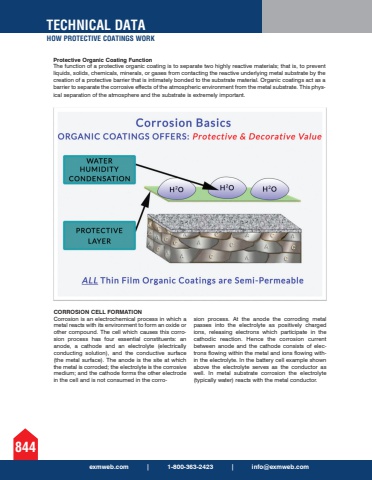Page 876 - Demo
P. 876
TECHNICAL DATAHOW PROTECTIVE COATINGS WORK844exmweb.com | 1-800-363-2423 | [email protected] Organic Coating FunctionThe function of a protective organic coating is to separate two highly reactive materials; that is, to prevent liquids, solids, chemicals, minerals, or gases from contacting the reactive underlying metal substrate by the creation of a protective barrier that is intimately bonded to the substrate material. Organic coatings act as a barrier to separate the corrosive effects of the atmospheric environment from the metal substrate. This physical separation of the atmosphere and the substrate is extremely important.CORROSION CELL FORMATION Corrosion is an electrochemical process in which a metal reacts with its environment to form an oxide or other compound. The cell which causes this corrosion process has four essential constituents: an anode, a cathode and an electrolyte (electrically conducting solution), and the conductive surface (the metal surface). The anode is the site at which the metal is corroded; the electrolyte is the corrosive medium; and the cathode forms the other electrode in the cell and is not consumed in the corrosion process. At the anode the corroding metal passes into the electrolyte as positively charged ions, releasing electrons which participate in the cathodic reaction. Hence the corrosion current between anode and the cathode consists of electrons flowing within the metal and ions flowing within the electrolyte. In the battery cell example shown above the electrolyte serves as the conductor as well. In metal substrate corrosion the electrolyte (typically water) reacts with the metal conductor.


